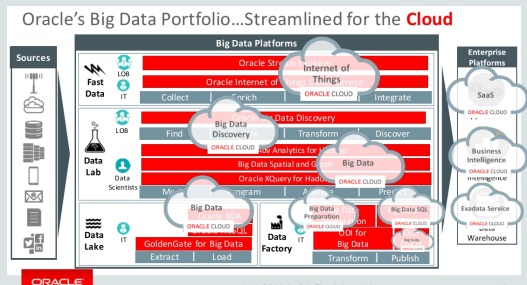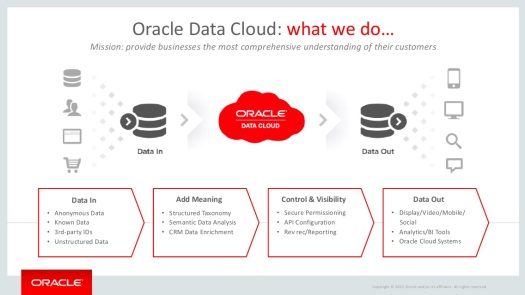Oracle Open World 2015 announcements included three data-related standouts: Oracle Cloud Platform For Big Data, Oracle Data Visualization Cloud Service, and Oracle Data Cloud. Here’s a deeper dive on what stands out.
Our cloud is integrated, it’s ready, and it’s bigger than and superior to any rival cloud. That was the big-picture message Oracle offered customers at Oracle Open World 2015. What’s more, the cloud is where most customers will soon be headed, said Oracle CEO Mark Hurd, predicting that “virtually all” enterprise data would be stored in the cloud by 2025.
It would be impossible to detail all two-dozen-plus announcements made last week, so I’ll narrow things to my Data-to-Decisions (D2D) research domain and focus on three announcements that caught my eye: The Oracle Cloud Platform For Big Data, the Data Visualization Cloud Service, and the Oracle Data Cloud. With all three, Oracle is trying to differentiate itself in the cloud.
Oracle Cloud Platform For Big Data
Oracle’s Hadoop-in-the-cloud Big Data Cloud Service was announced at Oracle Open World 2014. At Oracle Open World 2015 the company reannounced a family of supporting services newly packaged as the Oracle Cloud Platform for Big Data. The components include Oracle Big Data Preparation Cloud Service, Oracle GoldenGate Cloud Service, Oracle Big Data Discovery Cloud Service and Oracle NoSQL Database Cloud Service. The idea is to surround the Hadoop service with a breadth of data-prep, data-movement and data-analysis options.

The Oracle Cloud Platform for Big Data combines platforms (database, Hadoop, NoSQL) and analysis options.
I say “reannounce” because Oracle talked about all of these services back in June. The new “Cloud Platform for Big Data” is a new brand. The Oracle Big Data Preparation service is aimed at preparing and enriching semi-structured and unstructured data, such as clickstreams and social data. Under the hood it makes use of Apache Spark machine learning, Yago entity resolution training sets and Apache UIMA natural language processing.
The GoldenGate Cloud service is based on Oracle’s well-known data-replication software. This service is designed to pump data in near real time into Oracle Database Cloud Service, Exadata Cloud Service, Hive, Hbase, HDFS, Flume and Kafka (in this case, in the cloud). It’s a complement to low-latency, data-streaming applications, such as those in IoT scenarios.
The Oracle Big Data Discovery Cloud Service is a business-analyst-oriented tool for exploring, transforming and discovering data within Hadoop (again, in this case running in Oracle’s cloud). Data Discovery first samples, profiles and catalogs all available data. Machine-learning algorithms then surface interesting correlations and offer suggested visualizations for exploring attributes. Search and guided navigation features support data exploration.
Filling out Oracle’s Cloud Platform is the NoSQL Database Cloud service, which is Oracle’s high-scale key-value store database delivered as a service.
MyPOV: Not to be forgotten is the Oracle Big Data SQL Cloud Service, which does SQL querying across Oracle Database Cloud services, the Big Data Cloud Service and the NoSQL Database Cloud Service. Taken together, it’s a broad (if Oracle-centric) collection. IBM has a broader collection of IBM and open-source-based services on BlueMix, and Amazon Web Services has more customers using its cloud. But Oracle is building out an impressive portfolio, and the company’s dominant database position will surely feed cloud growth.
Oracle Data Visualization Cloud Service
Nearly every BI vendor has introduced a data-visualization module in recent years in response to the fast growth of Tableau Software. Oracle has evolved what it offers for the cloud with the Oracle Data Visualization Cloud Service. Set to become generally available in November, this new stand-alone service is based on capabilities first seen in the Oracle Business Intelligence Cloud Service introduced in April.

The Oracle Data Visualization Cloud Service offers 18 charting options and a palate of colors and shapes for depicting data.
The Oracle Data Visualization Cloud Service will enable you to link to on-premises and cloud data sources (both from Oracle and third parties) as well as your own spreadsheets. There are 18 different types of visualizations and a palate of colors, shapes and sizes for depicting data points.
Execs at Oracle Open World made a point of saying “all you need is a browser.” That’s because with Tableau’s cloud service, Tableau Online, users author charts and dashboards with the desktop client and then publish to the cloud for collaboration. Tableau is working on bringing full authoring capabilities to the cloud. And, indeed, Oracle is working on a desktop client for times when you need to work offline.
MyPOV: Oracle execs made claims about its new service being “more modern than Tableau” at Oracle Open World. That starts with full authoring capabilities in the cloud, but I’m not seeing some of the other differences claimed. The press release says Oracle’s service “eliminates the complexity typically associated with blending and correlating data sets,” but Tableau also automatically finds joins when mashing up data sets. Both products also select best-fit visualizations automatically based on the dimensions of data used in an analysis. This auto-charting capability has been around for a while, and it’s also present in SAS Visual Analytics and IBM Watson Analytics.
For a real head-to-head comparison with Tableau, I want to investigate Oracle’s performance characteristics and its connection capabilities (once this service is available). Tableau’s strengths include its in-memory engine and its live-data-connection capabilities with multiple databases, apps and cloud services, including multiple connection options with Amazon, Google, IBM, Microsoft, Oracle, Salesforce, SAP and others. Will Oracle match that? I also want to tour the “fit and finish” of the visualizations and “storytelling” capabilities. Some of the charts seen at Oracle Open World looked hard to read, but that may be due to the data-filtering and presentation inexperience of the demonstrators.
Yet-to-be released pricing details from Oracle will also be key to any comparison, but to me, these visualization capabilities are most attractive when teamed with the Oracle BI Cloud Service. That’s because it’s not only a data-exploration and visualization service; you also get the database and reporting functionality. Here, too, the more Oracle-centric you are in the on-premises world, the more attractive the cloud options will be.
Oracle Data Cloud
Several new features of the Oracle Data Cloud were announced at Oracle Open World, but a larger context emerged last week with IBM’s announced intent to acquire The Weather Company. Thus, I was eager to learn more about Oracle as a data provider. Oracle Data Cloud is built on technology, data and analytics expertise picked up in the BlueKai and Datalogix acquisitions. Talking to execs from both companies now leading Oracle Data Cloud, I came away impressed.

Oracle Data Cloud offers data from more than 1,500 specialty retailers and 30 supermarket loyalty cards.
Oracle Data Cloud offers offers data from more than 1,500 CPG and specialty retailers across 110 Million US Households. With data-enrichment and predictive analytics options on top of this data, Oracle can find likely buyers by product and category.
MyPOV: Having data and being able to enrich that data and apply predictive analytics is the name of the game in marketing, and these initiatives are moving into the sales and service arenas as well. In the business-to-business arena, Oracle Data Cloud can enrich your data with Dun & Bradstreet information to find look-alikes of your best customers. A next step is bringing service data full circle back into your understanding of customers to drive efforts such as retention campaigns.
Many tech vendors are introducing libraries of third-party data that are integrated with their offerings. But big guns like IBM and Oracle are stepping up to become primary data providers. Expect to see data from outside of your organization becoming a bigger and bigger part of your future success.


